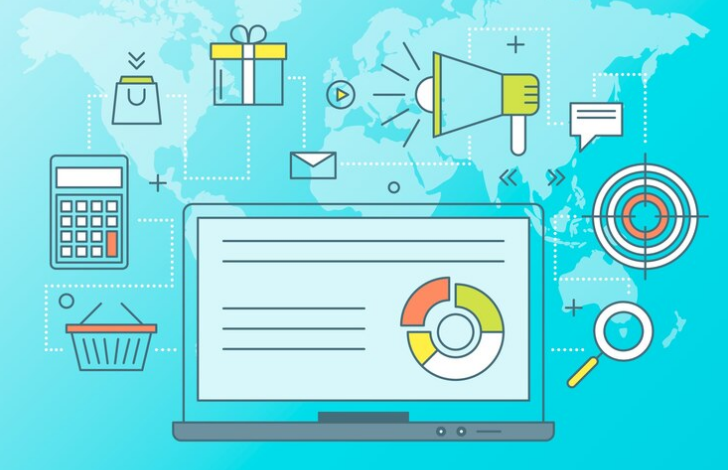The ecommerce landscape is constantly evolving, driven by technological advancements, changes in consumer behavior, and market dynamics. As businesses adapt to these changes, staying ahead of emerging trends is crucial for maintaining a competitive edge and growing in the digital marketplace. In this article, we’ll explore the most important trends shaping the future of ecommerce development services and how businesses can leverage them to thrive in the years ahead.
1. The Rise of Omnichannel Retail
Omnichannel retail is becoming increasingly important as consumers expect a seamless shopping experience across various touchpoints. In an omnichannel strategy, businesses integrate their online and offline channels—such as websites, mobile apps, social media, and physical stores—to provide a consistent and connected experience for customers.
a. Unified Customer Experience
An omnichannel approach allows customers to switch between channels without disruption. For example, a customer might browse products on their mobile phone, add items to their cart on a desktop, and complete the purchase in-store. By offering a seamless experience across these channels, businesses can increase customer satisfaction and drive loyalty.
b. Integration of Online and Offline Data
To successfully implement an omnichannel strategy, businesses must integrate data from both their online and offline channels. This enables them to track customer behavior, personalize marketing efforts, and offer features such as buy-online-pick-up-in-store (BOPIS). As more retailers adopt omnichannel strategies, this trend will become even more prominent in the ecommerce space.
2. The Growth of Voice Commerce
With the rise of voice-activated devices like Amazon Alexa, Google Assistant, and Siri, voice commerce is quickly gaining traction in the ecommerce world. Consumers are increasingly using voice commands to search for products, make purchases, and check order statuses. Voice commerce offers a hands-free, convenient way to shop, and it’s expected to become a major force in ecommerce.
a. Optimizing for Voice Search
Voice search optimization is becoming essential as more consumers use voice assistants to find products. Unlike traditional search queries, voice searches tend to be longer and more conversational. Ecommerce businesses will need to optimize their product descriptions and content for natural language queries to ensure their products show up in voice search results.
b. Voice-Enabled Shopping Assistants
Some brands are already experimenting with voice-enabled shopping assistants, allowing customers to complete entire purchases through voice commands. As voice recognition technology continues to improve, voice commerce is expected to become a standard shopping method for many consumers.
3. AI and Personalization
Artificial intelligence (AI) and machine learning are transforming the ecommerce landscape by enabling businesses to offer highly personalized experiences to customers. Personalization is no longer a luxury—it’s an expectation. AI-powered tools can analyze customer data, such as browsing history and purchase behavior, to deliver tailored product recommendations, personalized emails, and more.
a. Hyper-Personalized Shopping Experiences
In the future, ecommerce personalization will become even more granular, with AI enabling businesses to offer hyper-personalized experiences. This could include personalized product recommendations based on individual preferences, predictive product suggestions based on previous purchases, and real-time personalized offers delivered at the optimal moment in the customer journey.
b. AI-Powered Customer Support
AI is also transforming customer support with the rise of intelligent chatbots and virtual assistants. These AI-powered tools can handle routine customer inquiries, provide personalized recommendations, and offer 24/7 support, all without the need for human intervention. As AI technology continues to advance, we can expect even more sophisticated customer support solutions in the near future.
4. Augmented Reality (AR) and Virtual Reality (VR)
One of the biggest challenges in ecommerce is the inability to physically interact with products before making a purchase. Augmented reality (AR) and virtual reality (VR) are helping to bridge this gap by providing immersive shopping experiences that allow customers to visualize products in their own environment.
a. AR for Product Visualization
Augmented reality allows customers to see how products will look or fit in their real-world environment before making a purchase. For example, furniture retailers can use AR apps to let customers visualize how a sofa will look in their living room, or beauty brands can offer virtual makeup try-ons. By providing this interactive experience, AR reduces the uncertainty of online shopping and helps customers make more informed purchasing decisions.
b. VR for Immersive Shopping Experiences
Virtual reality takes the shopping experience to the next level by offering fully immersive experiences. For instance, VR could allow customers to walk through a virtual store, browse products, and even interact with sales associates. Although VR in ecommerce is still in its early stages, it has the potential to revolutionize online shopping by offering a more engaging and lifelike experience.
5. Sustainability and Ethical Shopping
Consumers are becoming more conscious of their impact on the environment and are increasingly seeking out brands that prioritize sustainability and ethical practices. As this trend continues, ecommerce businesses will need to adapt by offering more eco-friendly products and adopting sustainable business practices.
a. Sustainable Packaging and Shipping
Ecommerce businesses are under pressure to reduce their environmental footprint, particularly when it comes to packaging and shipping. More companies are turning to sustainable packaging options, such as biodegradable materials and minimalistic designs, to reduce waste. Additionally, offering carbon-neutral shipping or partnering with eco-friendly logistics providers can appeal to environmentally conscious consumers.
b. Transparency and Ethical Sourcing
Consumers want to know where their products come from and how they are made. Brands that are transparent about their sourcing, production processes, and ethical practices are more likely to build trust with their customers. In the future, ecommerce businesses will need to emphasize ethical sourcing, fair labor practices, and social responsibility to meet the growing demand for conscious consumption.
6. Social Commerce
Media has become a powerful sales channel, with platforms like Instagram, Facebook, and TikTok offering integrated shopping features. Social commerce allows consumers to discover products, read reviews, and make purchases directly through social media platforms without leaving the app. This trend is expected to grow as more platforms introduce native shopping features.
a. Shoppable Posts and Livestream Shopping
Shoppable posts on platforms like Instagram and Facebook allow users to click on tagged products and make purchases directly from their feed. Livestream shopping—where influencers or brand representatives showcase products in real time while interacting with viewers—has also become increasingly popular, especially in regions like China. This interactive, real-time shopping experience is likely to expand to other markets in the coming years.
b. User-Generated Content and Social Proof
Social commerce thrives on user-generated content and social proof. Customers are more likely to trust recommendations from real people, whether it’s influencers or fellow shoppers. By encouraging customers to share their purchases and reviews on social media, brands can build trust and increase their visibility within their target audience.
7. Mobile-First Commerce
As mobile usage continues to rise, ecommerce businesses must prioritize mobile-first design to meet the needs of on-the-go consumers. In fact, mobile commerce (m-commerce) is expected to account for nearly 73% of all ecommerce sales by 2024. This shift towards mobile shopping requires businesses to optimize their websites and checkout processes for mobile users.
a. Mobile-Optimized Websites and Apps
A mobile-optimized website is essential for providing a seamless shopping experience. This includes ensuring fast loading times, intuitive navigation, and touch-friendly interfaces. Many ecommerce businesses are also investing in mobile apps that offer additional features, such as personalized recommendations, push notifications, and loyalty programs.
b. Simplified Mobile Checkout
One of the biggest challenges in mobile commerce is cart abandonment, often due to complicated checkout processes. To combat this, businesses should implement one-click checkout options, offer digital wallets like Apple Pay and Google Pay, and simplify the payment process for mobile users. A smooth, fast checkout experience can significantly boost mobile conversion rates.
8. Subscription-Based Models
Subscription-based ecommerce models are on the rise, offering consumers convenience and predictability. These models work well for products that are purchased regularly, such as beauty products, household items, or food and beverages. Subscription services provide a steady revenue stream for businesses and offer customers the convenience of automated, recurring deliveries.
a. Personalized Subscription Services
Personalization is key to the success of subscription services. Many subscription-based businesses use AI and machine learning to offer personalized product recommendations and tailored subscription plans based on customers’ preferences and buying habits. This level of personalization not only enhances the customer experience but also increases retention rates.
b. Flexible Subscription Options
As subscription-based models continue to evolve, consumers are demanding more flexibility in how they manage their subscriptions. Offering customizable options—such as the ability to skip a month, change delivery frequency, or easily cancel—can improve customer satisfaction and reduce churn rates.
9. Blockchain and Cryptocurrency Payments
Blockchain technology and cryptocurrency are gaining traction in the ecommerce space, offering new possibilities for secure, transparent, and decentralized transactions. While still in its early stages, the use of blockchain and cryptocurrency in ecommerce is expected to grow as businesses and consumers become more familiar with the technology.
a. Secure Transactions with Blockchain
Blockchain technology offers enhanced security for online transactions by creating a decentralized ledger that cannot be altered. This makes transactions more secure and transparent, reducing the risk of fraud and data breaches. Ecommerce businesses that adopt blockchain technology can offer greater security and build trust with their customers.
b. Cryptocurrency as a Payment Option
As cryptocurrencies like Bitcoin and Ethereum become more mainstream, some ecommerce businesses are beginning to accept them as payment options. Offering cryptocurrency as a payment method can appeal to tech-savvy consumers and open up new markets, particularly in regions where traditional banking options are limited.
10. Conclusion: Embracing the Future of Ecommerce
The future of ecommerce website development company is full of exciting possibilities, with emerging technologies and evolving consumer expectations shaping the way businesses operate. By staying ahead of trends such as omnichannel retail, AI-driven personalization, voice commerce, and sustainability, ecommerce businesses can position themselves for long-term success in a rapidly changing marketplace.







More Stories
SEO-Friendly Web Design: User Experience
Increase Shopify Marketing Strategy with AI Avatars’ Video
The Future of E-Commerce Website Development